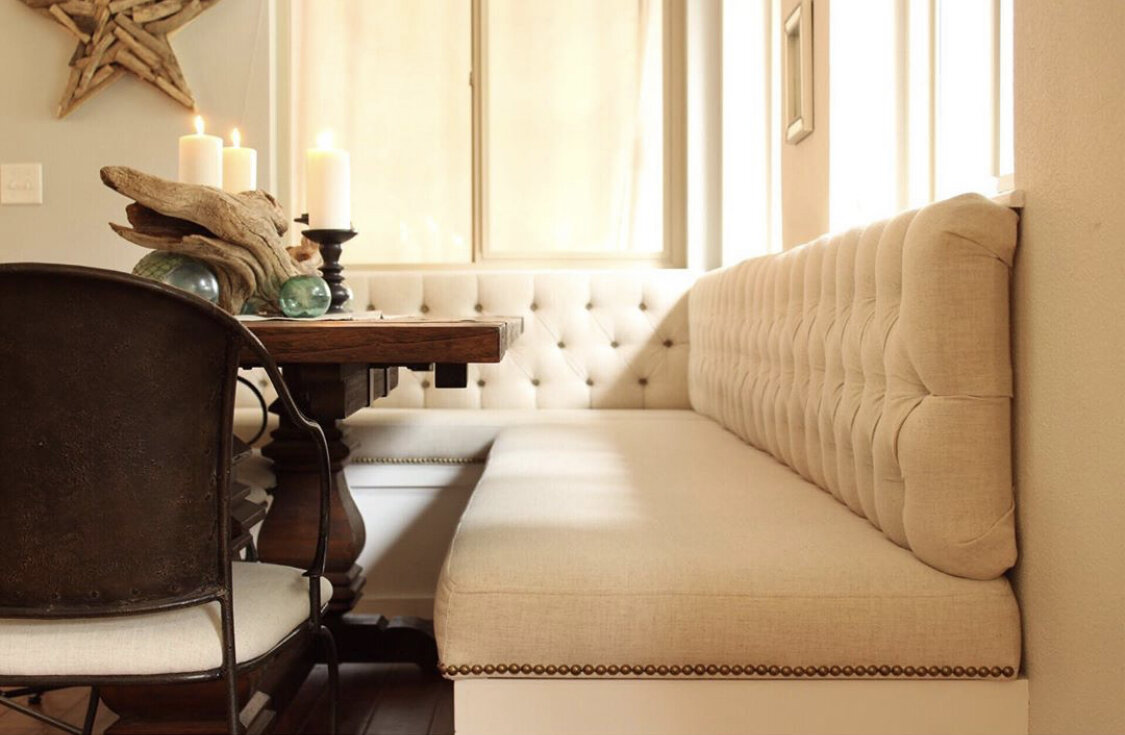How to Design the Perfect Banquette Seating Area
Banquette seating is one of my favorite ways to bring comfort, charm, and efficiency to a dining space. Whether it's a cozy breakfast nook or a custom bench built into your kitchen, the right banquette can turn a basic corner into the coziest seat in the house.
As an upholsterer, I’ve helped many clients create custom seating that fits both their space and their lifestyle. If you're thinking about adding a banquette to your home, here are the key design elements to get right—especially when it comes to comfort and proportions.
Start With Seat Height
For a banquette to be truly comfortable (and functional with your dining table), aim for a seat height of 18 inches from the floor to the top of the cushion. This matches standard chair height and keeps things ergonomic.
Tip: The firmness and density of the foam matters. I use high-density foam with a compression factor in mind. For example, a 3-inch foam may settle down to about 2.5 inches over time— design accordingly. If using a thinner foam, like for instance 2”, it will need to be firmer than a thicker piece such as 4”.
How Deep Should the Seat Be?
The seat depth depends on how the space will be used:
For upright dining and easy table access: 16–18 inches.
For a more lounge-style feel (especially with throw pillows): up to 22–24 inches.
If you’re working with a deeper bench, I often recommend adding a row of custom pillows or bolsters to bring support forward and give your back a break.
Backrest Height & Comfort
Most built-in banquettes look clean with a low-profile or mid-height backrest—typically 12–20 inches above the seat. For added comfort, a slight back angle of 5–10 degrees can make a big difference, especially for those long weekend brunches.
At Blue Roof Cabin, I can help you customize your backrest with options like:
Upholstered panels
Button tufting
Channels
Or custom pillows in all shapes and sizes
Don’t Forget Table & Leg Clearance
Make sure your table is 10–12 inches higher than the seat for proper legroom. If you’re working with a pedestal or trestle table, those often pair better with banquettes since they’re easier to slide in and out of.
Cushions & Fabric Matter
Your banquette will get a lot of use—meals, homework, coffee breaks—so your upholstery needs to be both beautiful and durable. I always recommend:
High-resilience foam for long-lasting comfort
Performance fabrics (Crypton, Revolution, or vinyl options) for stain-resistance
Easy-clean finishes, especially in homes with kids or pets
At Blue Roof Cabin, I offer a curated selection of upholstery fabrics.
Need Some Inspiration?
Here are a few ways I’ve seen clients bring banquettes to life:
L-shaped nook with fixed uphostered back panel and plywood wrapped seat.
Built-in window seat with a French Mattress cushion
Deep Tufted Back cushion with attached seat
You can view some of these transformations on my Instagram, where I share upholstery projects, DIY ideas, and behind-the-scenes peeks from my Shelton, WA workshop.
Let’s Create Your Dream Banquette
If you have a built-in bench ready for upholstery, or you’re in the early stages of planning your banquette, I’d love to help. I offer custom banquette cushions, backrests, and full-service upholstery tailored to your space.
Ready to get started? Contact me here to book a consult or get a quote.
